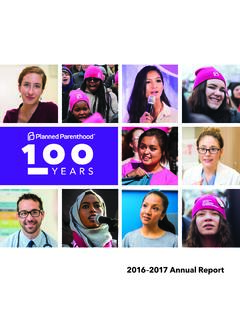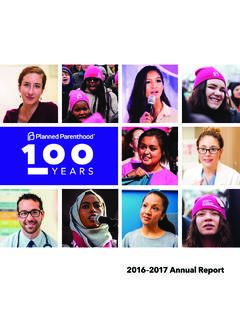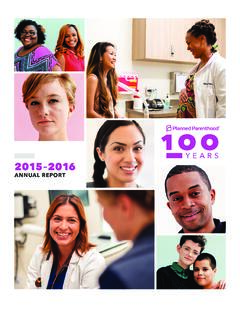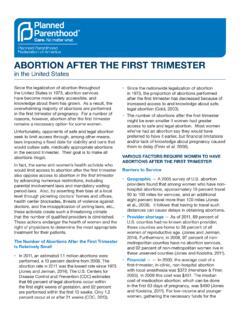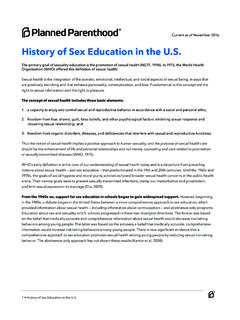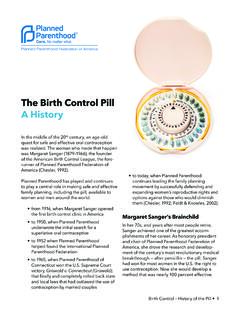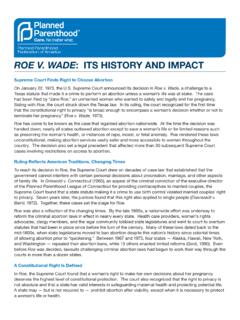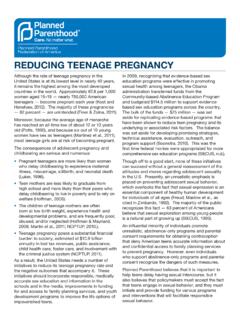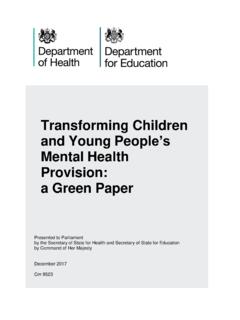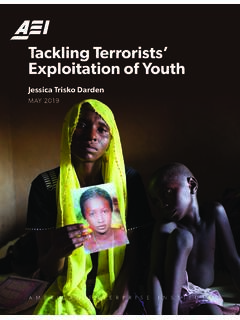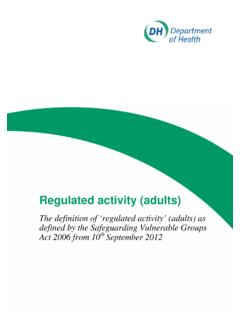Transcription of History of Sex Education in the U.S. - Planned Parenthood
1 Current as of November 2016. History of Sex Education in the The primary goal of sexuality Education is the promotion of sexual health (NGTF, 1996). In 1975, the World Health Organization (WHO) offered this definition of sexual health: Sexual health is the integration of the somatic, emotional, intellectual, and social aspects of sexual being, in ways that are positively enriching and that enhance personality, communication, and love. Fundamental to this concept are the right to sexual information and the right to pleasure. The concept of sexual health includes three basic elements: 1.
2 A capacity to enjoy and control sexual and reproductive behavior in accordance with a social and personal ethic;. 2. freedom from fear, shame, guilt, false beliefs, and other psychological factors inhibiting sexual response and impairing sexual relationship; and 3. freedom from organic disorders, diseases, and deficiencies that interfere with sexual and reproductive functions. Thus the notion of sexual health implies a positive approach to human sexuality, and the purpose of sexual health care should be the enhancement of life and personal relationships and not merely counseling and care related to procreation or sexually transmitted diseases (WHO, 1975).
3 WHO's early definition is at the core of our understanding of sexual health today and is a departure from prevailing notions about sexual health and sex Education that predominated in the 19th and 20th centuries. Until the 1960s and 1970s, the goals of social hygiene and moral purity activists eclipsed broader sexual health concerns in the public health arena. Their narrow goals were to prevent sexually transmitted infections, stamp out masturbation and prostitution, and limit sexual expression to marriage (Elia, 2009). From the 1960s on, support for sex Education in schools began to gain widespread support.
4 However, beginning in the 1980s, a debate began in the United States between a more comprehensive approach to sex Education , which provided information about sexual health including information about contraception and abstinence only programs. Education about sex and sexualtiy in schools progressed in these two divergent directions. The former was based on the belief that medically accurate and comprehensive information about sexual health would decrease risk-taking behaviors among young people. The latter was based on the erroneous belief that medically accurate, comprehensive information would increase risk-taking behaviors among young people.
5 There is now significant evidence that a comprehensive approach to sex Education promotes sexual health among young people by reducing sexual risk-taking behavior. The abstinence-only approach has not shown these results (Kantor et al, 2008). 1 History of Sex Education in the Medically-Accurate, Comprehensive Sex Education in Schools In 1964, Dr. Mary Calderone, medical director for Planned Parenthood Federation of America, founded the Sexuality Information and Education Council of the United States (SIECUS) out of her concern that young people and adults lacked accurate information about sex, sexuality, and sexual health (SIECUS, 2011a).
6 In 1990, SIECUS convened the National Guidelines Task Force, a panel of experts that constructed a framework within which local communities could design effective curricula and/or evaluate existing programs. The resulting Guidelines for Comprehensive Sexuality Education Kindergarten 12th Grade was published in 1991. Subsequent editions were published in 1996 and 2004 (NGTF, 2004). According to the National Guidelines Task Force, sexuality Education promotes sexual health in four ways: It provides accurate information about human sexuality, including growth and development, anatomy, physiology, human reproduction, pregnancy, childbirth, Parenthood , family life, sexual orientation, gender identity, sexual response, masturbation, contraception, abortion, sexual abuse, HIV/AIDS, and other sexually transmitted infections.
7 It helps young people develop healthy attitudes, values, and insights about human sexuality by exploring their community's attitudes, their family's values, and their own critical thinking skills so that they can understand their obligations and responsibilities to their families and society. It helps young people develop communication, decision-making, assertiveness, and peer-refusal skills so they are prepared to create reciprocal, caring, non-coercive, and mutually satisfying intimacies and relationships when they are adults. It encourages young people to make responsible choices about sexual relationships by practicing abstinence, postponing sexual intercourse, resisting unwanted and early sexual intercourse, and using contraception and safer sex when they do become sexually active (NGTF, 2004).
8 With the publication of the Guidelines, SIECUS also convened the National Coalition to Support Sexuality Education . The coalition now has over 160 member organizations that include the American Medical Association, the American Public Health Association, the American Psychiatric Association, the American Psychological Association, the National Urban League, and the YWCA of the (NCSSE, 2015). Since publication of the Guidelines, a large number of sex Education programs have been developed, implemented, and evaluated in order to understand which approaches to sex Education have the most success in helping move young people toward optimal sexual health.
9 In November 2007, the National Campaign to Prevent Teen and Unplanned Pregnancy published Emerging Answers, Douglas Kirby's summary of the findings of 115. studies conducted during the previous six years to measure the impact of sex Education programs. Of the 48 sexuality Education curricula he evaluated, he identified programs that improved sexual health outcomes for young people, through delaying first intercourse, reducing number of sex partners and frequency of sex, and increasing condom use and other contraceptives. Kirby identified 17 characteristics of effective curriculum-based programs based on his meta-analyses.
10 He sorted these characteristics into three categories. 2 History of Sex Education in the Kirby's 17 Characteristics of Effective Pregnancy and HIV/AIDS. Prevention Programs (Kirby, 2007). The Process Of Implementing The Contents Of The Curriculum Itself The Process Of Developing The Curriculum Of The Curriculum Secured at least minimal support Curriculum Goals and Objectives Involved multiple people with from appropriate authorities, expertise in theory, research, and such as departments of health, Focused on clear health goals the sex and STD/HIV Education to school districts, or community prevention of STD/HIV, pregnancy, develop the curriculum.
